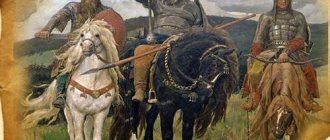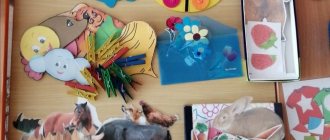Short-term project on traffic regulations
Municipal budgetary preschool educational institution kindergarten No. 8, Timashevsk
Project on the formation of traffic rules in the senior group “The road is our friend.”
Educator
Opletaeva T. A.
2020
Project on traffic rules in the senior group “The road is our friend.”
Project type: informational and educational.
Implementation time frame: mid-term (February – March 2022)
Project goal: Continue to familiarize children with the rules of the road; clarify and expand children’s knowledge about the elements of the road, traffic, and safe behavior on the streets of their hometown; formation of personal qualities: attention, responsibility for one’s behavior, confidence in one’s actions.
Develop logical thinking, attention, imagination, observation.
Systematize children's knowledge about traffic rules by playing out problem situations.
Project participants: children, parents of students, teacher
Tasks:
Educational:
expanding the general outlook on the problem of safe behavior on the streets and roads;
studying the Rules of the Road for pedestrians and passengers based on the development of skills and habits of safe behavior on the road;
formation of practical skills of pedestrians;
developing the ability to predict one’s behavior as a road user;
mastering by children, taking into account their age characteristics, sets of terms and concepts used in road traffic and contributing to the further successful acquisition of the basics of safe behavior on the roads.
Educational:
formation of road user culture;
fostering a negative attitude towards violators of behavioral norms and traffic rules.
Educational:
development of independence and the ability to rationally organize one’s activities in the process of road traffic;
development of logical and spatial thinking, imagination, memory.
Relevance
The relevance of this problem is due to the fact that preschool children do not have that protective psychological reaction to the road situation that is characteristic of adults. Their thirst for knowledge, the desire to constantly discover something new, often puts the child in front of real dangers, in particular on the streets.
These dangers can be avoided through appropriate upbringing and education of the child from a very early age. Preschool age is the most favorable for the formation of stable skills and habits. In a difficult situation, when danger arises, an adult’s instinct of self-preservation, dexterity, and quick reaction sometimes come to the rescue. Unfortunately, children do not fully possess these qualities and, when they find themselves in a critical situation, they get lost and cannot make the right decision, especially if they do not know the rules of the street.
Project on traffic rules in the kindergarten preparatory group
Project “Safe Wheel” on traffic rules in a preparatory school group
Description: Dear colleagues, I present to your attention the project passport for a preparatory school group on traffic rules.
This material can be used by preschool teachers, as well as primary school teachers. Project passport.
Project theme: “Safe Wheel”. Project manager: teacher Zhmurenko E.N. Type of project: educational, informational and creative Form of project: group Type of project: medium-term Duration of the project: 4 weeks Dates: March 13 - April 7, 2022 Composition of the project group: children of the preparatory group, parents, teachers of the group. Age of children: preparatory group, 6-7 years. Number of project participants: 25 (children) Integration of educational areas: cognitive development, social - communicative, artistic - aesthetic development, speech development, physical education, health. Relevance: Child road traffic injuries are currently one of the most pressing aspects of modern society. Especially in big cities with their frantic pace of life in a difficult traffic situation, where compliance with the norms and rules of behavior on the roads becomes quite a big problem, which depends both on government agencies (road legislation, control by the traffic police traffic inspection services), but and a huge responsibility is imposed on the road users themselves, and not only on adults, but also on children. Often the culprits in road traffic accidents are children themselves, who play near roads, cross the street at prohibiting signs and/or in the wrong places, ride bicycles on sections of roads where this is prohibited, and incorrectly enter and exit vehicles. This is caused by both elementary ignorance of the rules of the road by children themselves and the indifferent attitude of adults to the behavior of children on the roadway. The lack of a protective psychological reaction to the road situation, which is typical for adults, in children can lead to tragic consequences; Due to the absence of this reaction, children do not know how to properly control their behavior. The desire for the unknown, something new, their childish restlessness often puts them in a situation of real danger in a rapidly changing traffic situation. Therefore, starting from a very early age, it is necessary to teach children safe behavior on the road, street, in transport, as well as traffic rules. Knowledge and observance of the “Road Rules” will help to develop confident, responsible and safe behavior of children on the roads. cases on the roads. The effectiveness of teaching children traffic rules largely depends on the active participation of parents in joint activities with them. Thus, the relevance of the project lies in teaching preschool children the skills of safe behavior on the city streets. Significance of the project: Children develop the skills to proactively independently actively search for answers to questions that arise during the project and apply their skills in research, practical and creative activities. The stock of knowledge about the properties of water and its composition is expanding. Teachers continue to master design technology as a method of organizing rich children's activities, which makes it possible to expand the educational space, give it new forms, and effectively develop the creative cognitive thinking of a preschooler. Parents expand the possibilities of cooperation with their children and listen to their opinions. Project goals: Continue to form and reinforce in children, senior preschool age, the basics of safe behavior on the street and knowledge of traffic rules. Project objectives: 1. Create conditions for children to consciously study traffic rules. 2. Teach children the necessary minimum of traffic rules and road signs. 3. To form in children an idea of the organization of pedestrian and vehicle traffic on roads and streets. 4. Learn to take responsibility for the safety of your life and the lives of others. 5. Continue to develop in children the habit of correct behavior on the road. 6. Develop the ability to behave naturally in various situations and make the right decisions. 7. Enrich and expand the vocabulary of children's horizons. 8. Organize interaction with the family and kindergarten staff. Conditions for the project: 1. Interest of children and parents; 2. Regularity and systematic work; 3. Implementation through all types of children's activities Providing: games, posters on the topic, PowerPoint presentations on the topic, thematic illustrations and pictures, multimedia installation, tape recorder and flash media, educational and fiction literature on the topic, materials for creativity (cardboard, colored paper, paints, brushes, pencils, etc.) Expected result: • Children will learn more about traffic rules on the city streets; • The basics of safe behavior on the streets and roads and an understanding of the need to comply with traffic rules will be formed; • A sense of responsibility for preserving life and avoiding injuries on the city streets will be formed; • Get acquainted with the traffic police service; • Get acquainted with road signs: prohibiting, permitting, informational signs; • The level of motivation for collective achievements in children will increase; • An atmosphere of community of interests and partnerships will be created. Parents: • involving parents in the production of road signs, the “City Street” model, games on traffic rules within the framework of the project; • increasing interest in the work of preschool educational institutions Educators: • development of content and active management of the project will contribute to the accumulation of knowledge on traffic rules; • accumulation of practical didactic material on various types of children's activities as part of the work on the project Project plan: • Preparatory stage. • Practical activities. • Presentation. Products of activity: 1) layouts of “City Streets” and “Vehicles”; 2) an album with children’s drawings about traffic rules; 3) leisure “About the one who risked his life on the pavement” (scenario); 4) exhibition of project products (drawings, layouts) Form of defense: presentation of the project for parents and teachers on the preschool educational institution website.
Description of the project.
Project stages: Stage I. Preparatory At the first stage, search work was carried out to select material on this topic. The goal and objectives of the project are determined. A work plan for the project has been drawn up. Together with the children, the task was determined: to develop skills for safe behavior on the streets and roads and to understand the need to follow traffic rules. Parents were involved in the project: the production of road signs, “City Streets” and “Vehicles” models, and games on road safety. The result of stage 1 was a project plan, the children were given a problem that had to be solved, and also to convey to the children the knowledge of what road rules must be followed. Stage II - Basic. Duration - 1 week At the 2nd stage of the project, to implement the assigned tasks, the work took place in the process of implementing all educational areas: social and communicative development, cognitive development, speech development, physical development and artistic and aesthetic development. In her work, she used a wide variety of forms of work with preschoolers:
• Thematic conversations (“Road Rules”, “City Street”);
• Integrated lesson-conversation “Rules of behavior in public transport” • OOD (“Driving school”, “Always follow the traffic rules”) • Role-playing game “Traffic on a city street”; • Quiz “Pedestrian on the street”, Word game “What? Where? Where?" • Didactic games; • Productive activities, etc. A subject-developing environment has been created:
• Model “City Streets”, “Vehicles” • Corner on road safety, • Exhibition of literature on the topic, • Didactic games, • Attributes for role-playing games A
“Traffic Regulations” stand and moving folders have been made for parents:
• “Techniques for teaching a young pedestrian”, • “The most attentive pedestrian”, • “About the rules of the road”
Consultations were held for parents:
• “Your child is on the street.
Parent, remember! • “For parents - about road safety”, • “Three laws of pedestrian safety on the road” Didactic games, role-playing games, a traffic rules quiz increased the efficiency and effectiveness of the work on studying traffic rules. Each of the children wanted to show their knowledge. The students took an active part in the drawing competition on traffic rules. The result of stage 2 was that children received and consolidated knowledge about traffic rules, road signs, and developed the ability to express and justify their opinions in games and other activities. Stage III – Final (presentation). Duration: 1 week Purpose: summing up the project activities. Objectives: 1. Systematize children’s knowledge about traffic rules.
2. Create an album of children's drawings. 3. Design an exhibition and prepare a presentation of the finished products of the project (model “City Streets”, models of vehicles, drawings of children). 4. Preparation and holding of a competition of creative works within the framework of the project for the production of a model of “City Streets” and “Vehicles”. 5. Preparation and conduct of leisure time “About the one who risked his life on the pavement” 6. Presentation of the project on the website of the preschool educational institution. Results of the project:
The “Safe Wheel” project was another proof and a striking example that solving the problem of preventing children’s road traffic injuries is possible only through the joint efforts of teachers, parents, and children.
• Children learned more about traffic rules on the city streets; • A sense of responsibility has been formed for preserving life and avoiding • injuries on the city streets; • The basics of safe behavior on the streets and roads and an understanding of the need to comply with traffic rules have been formed; • Familiarized yourself with prohibiting, permitting, informational and • indicative signs; • We got acquainted with the traffic police service; • The level of motivation for collective achievements in children has increased; • An atmosphere of community of interests and partnerships has been created (children, parents, educators) Literature used: 1. N.A. Izvekova / Traffic rules. – M.: Education, 1982. 2. N.A. Izvekova/ Traffic rules for preschool children. - M.: Creative, 2006. 3. L.B. Poddubnaya / Traffic rules. Entertaining materials. – Volgograd, Publishing house – trading house
We recommend watching:
Project in a kindergarten for older preschoolers 5-7 years old on legal topics Project for Victory Day at school Using Soviet cartoons in preparing older preschool children for school Project in the senior and preparatory group of a kindergarten
Similar articles:
Tasks on traffic rules for preschoolers in pictures
Learning traffic rules in kindergarten
Lesson on traffic rules in kindergarten for children of the preparatory group. Traffic certificate
Game quiz on traffic rules in the preparatory group of kindergarten
Summary of a lesson on traffic rules for children of the preparatory group at the kindergarten site
Pedagogical project in the preparatory group of the preschool educational institution “Road Rules”
- September 7, 2017
International and All-Russian competitions
All-Russian competition of pedagogical excellence “Methodological piggy bank of a kindergarten teacher”
The relevance of the problem is due to the fact that preschool children do not have that protective psychological reaction to the road situation that is characteristic of adults. Their thirst for knowledge, the desire to constantly discover something new, often puts children in front of real dangers, in particular on the streets.
To protect children from danger, it is necessary to gradually begin to prepare them for encounters with the street and traffic as early as possible. Learn to turn to elders for help, counting on their responsiveness.
The sooner we introduce a child to the rules of the road and develop his behavioral skills in transport and on the street, the fewer incidents he will have on the road.
Type, type of project: creative and educational.
Project duration: short-term.
Project participants : teachers, older children, parents.
Project goal: To develop in preschool children the skills and abilities of safe behavior in the surrounding road transport environment.
Project objectives:
Educational:
- introduce children to traffic rules and
- signs intended for drivers and pedestrians, with the work of the State Road Safety Inspectorate;
- teach children to anticipate a dangerous event, be able to avoid it if possible, and act if necessary.
Educational:
- develop caution, attentiveness, independence, responsibility and prudence on the road;
- stimulate cognitive activity, promote development
- communication skills;
- promote the development of children’s speech, replenish children’s active and passive vocabulary in the process of working on a project, develop coherent speech;
Educational: develop personal safety skills and a sense of self-preservation.
Conditions for the project:
- Interest of children and parents;
- regularity and systematic work;
- implementation through all types of children's activities.
Availability of resource base:
- a specially equipped area on the street (remote mock-ups of road signs, markings of the intersection and adjacent roads, as well as pedestrian crossings, sidewalks, mock-ups of vehicles, traffic police uniform);
- layouts of road signs, markings of intersections and adjacent roads, as well as pedestrian crossings, sidewalks, layouts of vehicles;
- layout with appropriate markings and road signs;
- didactic games; illustrations, paintings, multimedia presentations;
- attributes for the role-playing games “Road Traffic”, “Bus Travel”, etc.
Implementation of the project through the integration of educational areas:
Cognitive development, speech development, social and communicative development, artistic and aesthetic development.
Project stages
Stage 1 (problem formulation)
Setting the problem for children “Why is it necessary to know the rules of the road?”
Activity planning:
- defining the goals and objectives of the project;
- drawing up a project plan;
- search work to select illustrative material on the topic of the project;
- production and acquisition of gaming material;
- organization of excursions;
- a selection of fiction on the topic of the project;
- parents' organization.
Stage 2 (discussion of the problem, acceptance of tasks)
Make children aware of the importance of this problem: “Ignorance of traffic rules can lead to trouble!”
- The purpose of the walk is an excursion to the crossroads.
- Making the route “Home - kindergarten”.
- Organized educational activities:
- entertainment on traffic rules for children of the preparatory group “How Mashenka was taught the rules of the road”;
- intellectual game “What? Where? When?"?" according to traffic rules;
- game - quiz “Signs on the roads”;
- physical education according to the traffic rules “ABC of Safety”.
- View presentations on traffic regulations. “Road signs”, “Fun traffic light”.
- Reading fiction. S. Volkova “About traffic rules”; O. Bedarev “The ABC of Security”; S. Mikhalkov “Three wonderful colors”, “My street”.
- Didactic games “Mazes”, keyboard “Road signs and cars” “Cut-out pictures”, “Pedestrian ABC”, “Transport”, lotto “Pedestrian”, “You need to know this”.
- Role-playing games: “Pedestrians and cars”, “Traffic lights” and others.
- “Coloring pages with traffic rules for preschoolers”, “Origami”, “Road signs”, “Our street”.
- Design of a memo and stand for parents, “Beware of the Street”, wall game “Crossroads”.
Stage 3 (presentation)
Intellectual game “What? Where? When?"?" according to traffic rules.
Stage 4 (statement of a new problem)
Creation of a mini-museum.
Stage of summing up the results of activities
The positive results of the project can be assessed by the following indicators:
- High level of children’s knowledge of the rules of safe behavior on the streets and roads (in accordance with age requirements).
- Children have motivation to work independently on this topic.
- The level of children's involvement in solving this problem.
- The manifestation of a negative attitude in children towards traffic violations.
- Children's activity during competitions and various events.
- Children’s ability to quickly and correctly navigate traffic situations (in various game situations);
- Activation of parents and children at events.
Conclusion
The sooner children learn a culture of behavior on the roads and streets, the fewer incidents there will be on the roadways. The pupil is a new road user, a disciplined pedestrian, a cultured passenger.



